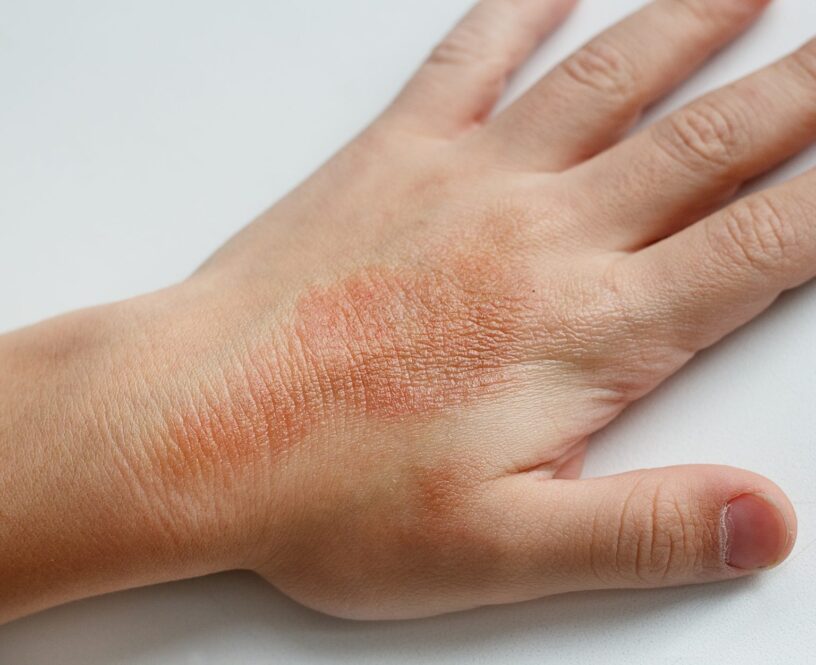The Allergic Contact Dermatitis (ACDS) Market focuses on the diagnosis, treatment, and management of allergic contact dermatitis, a type of skin inflammation triggered by an allergic reaction to various allergens such as metals, fragrances, preservatives, and certain chemicals. ACDS is a prevalent condition affecting individuals worldwide, leading to skin irritation, itching, redness, and swelling upon exposure to allergens. The market is driven by the increasing prevalence of contact dermatitis due to rising exposure to allergens in industrial, cosmetic, and healthcare environments, along with advancements in diagnostic tools and treatment options.
Key Components and Market Drivers:
- Diagnostic Tools and Products:
- Patch Testing Kits: These are essential diagnostic tools for identifying allergens responsible for triggering allergic contact dermatitis. Patch testing involves placing small amounts of potential allergens on the skin and observing reactions. Popular kits include panels for common allergens such as nickel, latex, parabens, and fragrances. This segment is growing as awareness of ACDS increases, prompting more frequent and thorough testing.
- In Vitro Testing: Emerging in vitro diagnostic technologies are being developed to detect allergic reactions at the cellular level. These tests offer faster and more specific results compared to traditional patch testing, contributing to the growing demand for more efficient diagnostic solutions.
- Point-of-Care Testing: Portable testing devices that allow dermatologists and healthcare providers to diagnose contact dermatitis quickly and effectively are gaining traction, particularly in outpatient settings. These are particularly beneficial in regions where access to advanced testing facilities is limited.
- Treatment Options and Market Drivers:
- Topical Corticosteroids: The primary treatment for managing the symptoms of ACDS includes topical corticosteroids, which reduce inflammation and itching. These creams and ointments, available in both prescription and over-the-counter formulations, are widely used and constitute a significant share of the market.
- Emollients and Barrier Creams: Moisturizing creams and emollients help soothe the irritated skin and form a protective barrier against allergens. These products are essential in both the treatment and prevention of contact dermatitis flare-ups, especially in individuals with chronic conditions. Barrier creams are also popular in industries where workers are exposed to irritants.
- Immunosuppressants and Biologics: In severe or chronic cases, oral corticosteroids or immunosuppressants like cyclosporine may be prescribed. There is also ongoing research into biologic treatments, such as Dupilumab, which has shown promise in treating other skin conditions like atopic dermatitis and may expand to allergic contact dermatitis in the future.
- Rising Prevalence of Skin Allergies: The increasing use of cosmetics, industrial chemicals, and personal care products containing potential allergens has led to a higher incidence of ACDS. This rise in skin sensitivities and allergies is one of the key market drivers, as more patients seek effective treatments.
- Competitive Landscape and Market Trends:
- Key Players: The ACDS market includes pharmaceutical companies, dermatology product manufacturers, and diagnostic kit providers. Some key players include:
- GlaxoSmithKline (GSK): A leader in dermatology treatments, including topical steroids and anti-inflammatory medications.
- Johnson & Johnson: A major player in over-the-counter skin treatments, including moisturizing and barrier creams.
- Pfizer: Provides prescription corticosteroids and other treatments for severe allergic reactions.
- Nestlé Skin Health (Galderma): Focuses on advanced dermatology treatments, including emollients and prescription therapies.
- SmartPractice: Specializes in allergy testing and provides patch test kits for diagnosing allergic contact dermatitis.
- Market Trends: A notable trend in the ACDS market is the shift toward natural and hypoallergenic products. With growing consumer awareness about the harmful effects of chemicals, there is an increasing demand for clean-label or natural skincare products that reduce the risk of allergic reactions. This is particularly evident in the personal care and cosmetics segments, where companies are reformulating products to exclude common allergens like parabens and phthalates.
- Personalized Dermatology: Advances in personalized medicine are influencing the market, with treatments increasingly tailored to individual patient profiles. As patch testing and diagnostic tools become more sophisticated, healthcare providers can more accurately identify the specific allergens causing ACDS and recommend targeted treatments.
- Challenges: Despite advances, the market faces challenges, including underdiagnosis and misdiagnosis of ACDS, particularly in regions with limited access to dermatology specialists. Additionally, long-term use of topical corticosteroids can lead to side effects, prompting the need for more safe and effective treatments. Regulatory hurdles also play a role, particularly in the approval of new treatments like biologics.
- Key Players: The ACDS market includes pharmaceutical companies, dermatology product manufacturers, and diagnostic kit providers. Some key players include:
Conclusion:
The Allergic Contact Dermatitis (ACDS) Market is expected to grow steadily, driven by the rising prevalence of allergic reactions, increasing awareness of skin conditions, and advancements in diagnostic and therapeutic solutions. The demand for effective treatments, especially for chronic or severe cases, is leading to innovation in both traditional topical treatments and emerging biologic therapies. With a shift toward hypoallergenic and natural products, the market is likely to expand as consumers seek safer and more personalized options for managing allergic contact dermatitis.
Click Here, To Get Free Sample Report https://stringentdatalytics.com/sample-request/allergic-contact-dermatitis-(acds)-market/14675/
Market Segmentations:
Global Allergic Contact Dermatitis (ACDS) Market: By Company
Sandoz
Akorn
Perrigo Company
Taro Pharmaceuticals
Teva Pharmaceuticals
Glenmark Pharmaceuticals
Global Allergic Contact Dermatitis (ACDS) Market: By Type
Glucocorticoids
Topical Steroids
Miscellaneous Topical Agents
Corticosteroid
Anticholinergic Antiemetic
Miscellaneous Anxiolytics, Sedatives and Hypnotics
Global Allergic Contact Dermatitis (ACDS) Market: By Application
Topical Administration
Oral Administration
Global Allergic Contact Dermatitis (ACDS) Market: Regional Analysis
The regional analysis of the global Allergic Contact Dermatitis (ACDS) market provides insights into the market’s performance across different regions of the world. The analysis is based on recent and future trends and includes market forecast for the prediction period. The countries covered in the regional analysis of the Allergic Contact Dermatitis (ACDS) market report are as follows:
North America: The North America region includes the U.S., Canada, and Mexico. The U.S. is the largest market for Cold-chain Pharma in this region, followed by Canada and Mexico. The market growth in this region is primarily driven by the presence of key market players and the increasing demand for the product.
Europe: The Europe region includes Germany, France, U.K., Russia, Italy, Spain, Turkey, Netherlands, Switzerland, Belgium, and Rest of Europe. Germany is the largest market for Cold-chain Pharma in this region, followed by the U.K. and France. The market growth in this region is driven by the increasing demand for the product in the automotive and aerospace sectors.
Asia-Pacific: The Asia-Pacific region includes Singapore, Malaysia, Australia, Thailand, Indonesia, Philippines, China, Japan, India, South Korea, and Rest of Asia-Pacific. China is the largest market for Cold-chain Pharma in this region, followed by Japan and India. The market growth in this region is driven by the increasing adoption of the product in various end-use industries, such as automotive, aerospace, and construction.
Middle East and Africa: The Middle East and Africa region includes Saudi Arabia, U.A.E, South Africa, Egypt, Israel, and Rest of Middle East and Africa. The market growth in this region is driven by the increasing demand for the product in the aerospace and defense sectors.
South America: The South America region includes Argentina, Brazil, and Rest of South America. Brazil is the largest market for Cold-chain Pharma in this region, followed by Argentina. The market growth in this region is primarily driven by the increasing demand for the product in the automotive sector.
Click Here, To Buy Premium Report https://stringentdatalytics.com/purchase/allergic-contact-dermatitis-(acds)-market/14675/?license=single
Reasons to Purchase this Market Report:
- The competitive environment includes the proportions of important players, recent innovations, and strategy.
- Companies with extensive product offerings, pertinent financial data, recent advancements, SWOT analyses, and player tactics.
- Quantitative, qualitative, value (in USD million), and volume (in units million) data are among the segments and sub-segments.
- The research contains a wealth of data, including market dynamics and opportunities throughout the forecast period.
- Data at the regional, sub-regional, and national levels also provides information on the market’s supply and demand dynamics.
About Stringent Datalytics
Stringent Datalytics offers both custom and syndicated market research reports. Custom market research reports are tailored to a specific client’s needs and requirements. These reports provide unique insights into a particular industry or market segment and can help businesses make informed decisions about their strategies and operations.
Syndicated market research reports, on the other hand, are pre-existing reports that are available for purchase by multiple clients. These reports are often produced on a regular basis, such as annually or quarterly, and cover a broad range of industries and market segments. Syndicated reports provide clients with insights into industry trends, market sizes, and competitive landscapes. By offering both custom and syndicated reports, Stringent Datalytics can provide clients with a range of market research solutions that can be customized to their specific needs.
Contact Us
Stringent Datalytics
Contact No- +1 346 666 6655
Email Id- sales@stringentdatalytics.com
Web- https://stringentdatalytics.com/




Leave a Reply